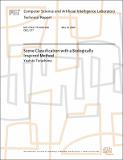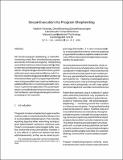Browsing Computer Science and Artificial Intelligence Lab (CSAIL) by Title
Now showing items 3012-3031 of 3804
-
A scenario of Planning and Debugging in Electronic Circuit Design
(MIT Artificial Intelligence Laboratory, 1973-12)The purpose of this short document is to exhibit how a HACKER-like top-down planning and debugging system can be applied to the problem of the design and debugging of simple analog electronic circuits. I believe, and I ... -
Scene Classification with a Biologically Inspired Method
(2009-05-10)We present a biologically motivated method for scene image classification. The core of the method is to use shape based image property that is provided by a hierarchical feedforward model of the visual cortex [18]. Edge ... -
Scheduling Task Systems with Resources
(1980-05)Minimum execution time scheduling of task systems with resources has been the subject of several papers over the past few years. The model used for much of this work assumes that the resources in the system are continuous. ... -
Schematic Querying of Large Tracking Databases
(2006-06-12)In dealing with long-term tracking databases withwide-area coverage, an important problem is in formulating anintuitive and fast query system for analysis. In such a querysystem, a user who is not a computer vision research ... -
Scheme 86: An Architecture for Microcoding a Scheme Interpreter
(1988-08-01)I describe the design and implementation plans for a computer that is optimized as a microcoded interpreter for Scheme. The computer executes SCode, a typed-pointer representation. The memory system has low-latency as ... -
A Scheme Shell
(1994-04) -
The SCHEME-79 Chip
(1980-01-01)We have designed and implemented a single-chip microcomputer (which we call SCHEME-79) which directly interprets a typed pointer variant of SCHEME, a dialect of the language LISP. To support this interpreter the chip ... -
Scheme86: A System for Interpreting Scheme
(1988-04-01)Scheme86 is a computer system designed to interpret programs written in the Scheme dialect of Lisp. A specialized architecture, coupled with new techniques for optimizing register management in the interpreter, allows ... -
SCHEME: An Interpreter for Extended Lambda Calculus
(1975-12-01)Inspired by ACTORS [Greif and Hewitt] [Smith and Hewitt], we have implemented an interpreter for a LISP-like language, SCHEME, based on the lambda calculus [Church], but extended for side effects, multiprocessing, and ... -
The Scientific Community Metaphor
(1981-01-01)Scientific communnities have proven to be extremely successful at solving problems. They are inherently parallel systems and their macroscopic nature makes them amenable to careful study. In this paper the character of ... -
Scoop: An Adaptive Indexing Scheme for Stored Data in Sensor Networks
(2006-11-27)In this paper, we present the design of Scoop, a system for indexing and querying stored data in sensor networks. Scoop works by collecting statistics about the rate of queries and distribution of sensor readings over a ... -
SCPLOT BIN
(1966-10-01)This program will take a list of display instructions and cause it to be plotted. For further or more detailed information consult with Michael Speciner. -
SE-Sync: A Certifiably Correct Algorithm for Synchronization over the Special Euclidean Group
(2017-02-05)Many important geometric estimation problems naturally take the form of synchronization over the special Euclidean group: estimate the values of a set of unknown poses given noisy measurements of a subset of their pairwise ... -
Search Procedures Based on Measures of Relatedness Between Documents
(1966-06)In this thesis a new type of information retrieval system is suggested which utilizes data of the type generated by the users of the system instead of data generated by indexers. The theoretical model on which the system ... -
Secondary Storage in LISP
(1963-12-01)A principal limitation of LISP processors in many computations is that of inadequate primary random-access storage. This paper explores several methods of using a secondary storage medum (such as drums, disk files or magetic ... -
Secondary Structure Prediction of All-Helical Proteins Using Hidden Markov Support Vector Machines
(2005-10-06)Our goal is to develop a state-of-the-art predictor with an intuitive and biophysically-motivated energy model through the use of Hidden Markov Support Vector Machines (HM-SVMs), a recent innovation in the field of machine ... -
A Secure and Flexible Model of Process Initiation for a Computer Utility
(1976-06)This thesis demonstrates that the amount of protected, privileged code related to process initiation in a computer utility can be greatly reduced by making process creation unprivileged. The creation of processes can be ... -
Secure Computation (Preliminary Report)
(1991-08)We define what it means for a network of communicating players to securely compute a function of privately held inputs. Intuitively, we wish to correctly compute its value in a computer manner which protects the privacy ... -
Secure Execution Via Program Shepherding
(2002-02)We introduce program shepherding, a method for monitoring control flow transfers during program execution to enforce a security policy. Shepherding ensures that malicious code masquerading as data is never executed, thwarting ...



















